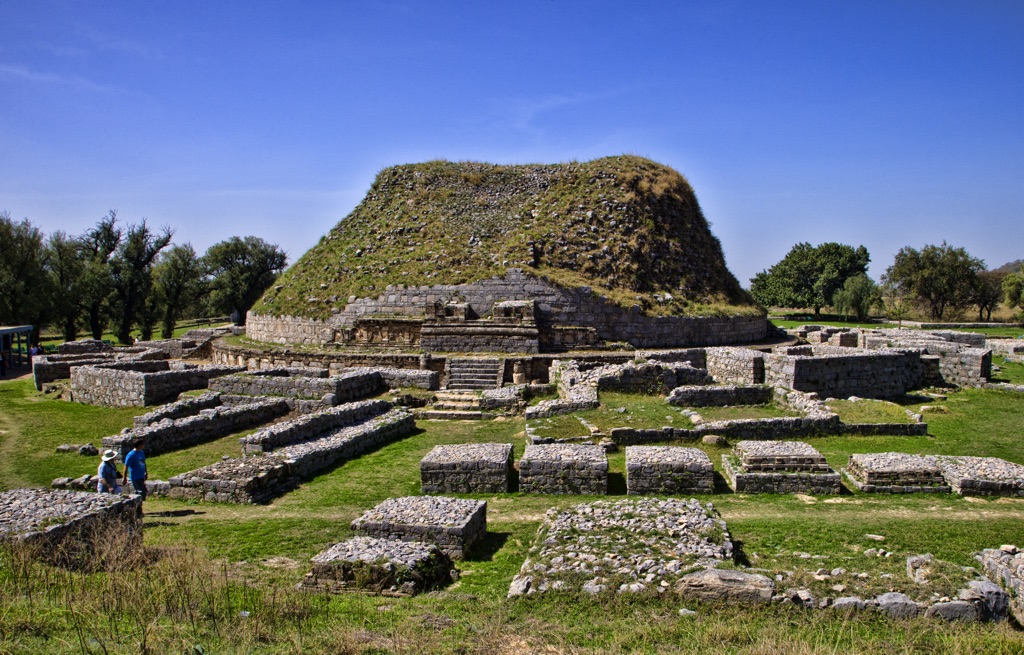The Dharmarajika Stupa, a significant Buddhist structure, stands as a testament to the religion’s ancient roots and influence. This stupa, located in Taxila, Pakistan, is part of a larger complex that was once a hub for Buddhist learning and worship. It is believed to have been established by Emperor Ashoka in the 3rd century BC. The Dharmarajika Stupa holds not only religious significance but also historical and archaeological importance, as it provides insights into the Buddhist culture that once flourished in the region.
Get your dose of History via Email
Historical Background of The Dharmarajika Stupa
The Dharmarajika Stupa, nestled in the heart of Taxila, is a relic of the past that whispers tales of ancient times. Sir John Marshall, a British archaeologist, unearthed this treasure in the early 20th century. The stupa’s creation is credited to the Mauryan emperor Ashoka, a patron of Buddhism. Over the centuries, the site saw various inhabitants and underwent numerous renovations. It stood as a silent witness to the ebb and flow of empires and the spread of Buddhism.
Emperor Ashoka, renowned for his role in spreading Buddhism, established the Dharmarajika Stupa as a sacred repository for relics. The stupa’s strategic location in Taxila, a key city on the trade routes, allowed it to become a focal point for pilgrims and scholars. As Buddhism evolved, the stupa also transformed, reflecting the changing architectural styles and religious practices of the time.
Throughout its history, the Dharmarajika Stupa has seen various additions and embellishments. Monks and pilgrims from distant lands visited, leaving behind a mosaic of cultural influences. The site also played a role in significant historical events, serving as a beacon of Buddhism in the region. Its influence waned with the decline of Buddhism in the subcontinent, leading to its eventual abandonment.
The rediscovery of the Dharmarajika Stupa by Sir John Marshall marked a new chapter in its story. Archaeological excavations revealed a complex history, with layers of construction pointing to a continuous use over many centuries. The stupa’s significance extends beyond religion, offering a window into the social and political life of ancient Taxila.
Today, the Dharmarajika Stupa stands as a monument to the enduring legacy of Buddhism. It attracts historians, archaeologists, and tourists alike, each seeking to understand the depth of its past. The stupa’s history is a tapestry woven from threads of conquest, devotion, and enlightenment, highlighting the rich cultural heritage of the region.
About The Dharmarajika Stupa
The Dharmarajika Stupa is a marvel of ancient engineering and religious architecture. Its core is a solid hemisphere of earth and stone, encased in a shell of burnt bricks. The stupa’s design follows the traditional Buddhist architectural principles, symbolizing the path to enlightenment. The structure is crowned with a series of chatras, representing the sovereignty of the Buddha.
Surrounding the main stupa are smaller votive stupas, each a tribute from devout followers. These stupas are adorned with intricate carvings and stucco decorations, showcasing the artistic skills of the craftsmen. The entire complex was once enclosed by a boundary wall, creating a sacred space for meditation and worship.
The construction techniques of the Dharmarajika Stupa reflect the ingenuity of its builders. The use of sundried and fired bricks, the precise alignment of the structures, and the drainage systems to protect against the elements—all speak of a sophisticated understanding of civil engineering. The stupa’s layout is carefully planned, with a main entrance and a processional path for circumambulation.
Architectural highlights of the Dharmarajika Stupa include the decorative elements that adorn the structure. Floral motifs, geometric patterns, and figures from Buddhist lore are etched into the stone and stucco. These elements not only enhance the stupa’s beauty but also convey religious teachings and stories.
The Dharmarajika Stupa’s building materials have withstood the test of time, preserving the legacy of the artisans. The bricks and stone used in its construction have survived centuries of weathering, providing a tangible link to the past. The stupa’s architectural features offer a glimpse into the evolution of Buddhist art and architecture in the region.
Theories and Interpretations
The Dharmarajika Stupa has been the subject of various theories and interpretations over the years. Scholars believe it was built to house sacred relics of the Buddha, serving as a focal point for veneration. The presence of numerous votive stupas suggests a strong tradition of pilgrimage and offering at the site.
Some mysteries shroud the Dharmarajika Stupa, particularly regarding the exact nature of the relics it once contained. While some suggest they were physical remains of the Buddha, others propose they were objects associated with his life. The true contents remain a topic of debate and fascination among historians.
The stupa’s architectural features have also been interpreted in light of Buddhist teachings. The circular path around the stupa is seen as a representation of the cycle of life, death, and rebirth. The ascent to the top symbolizes the journey towards enlightenment, a core concept in Buddhism.
Dating the Dharmarajika Stupa has involved various methods, including stratigraphy and typological analysis. These techniques have helped establish a timeline for the stupa’s construction and subsequent modifications. The consensus places its origin in the 3rd century BCE, with renovations spanning several centuries.
The Dharmarajika Stupa continues to be a subject of academic interest, with ongoing research shedding light on its history and significance. Each layer of excavation and interpretation adds to the understanding of this ancient monument, piecing together the puzzle of its storied past.
At a glance
- Country: Pakistan
- Civilization: Mauryan Empire
- Age: Approximately 2,300 years (3rd century BC)
Conclusion and Sources
- Wikipedia – https://en.wikipedia.org/wiki/Dharmarajika_Stupa
- Britannica – https://www.britannica.com/topic/stupa
- World History Encyclopedia – https://www.worldhistory.org/Taxila/
- UNESCO – https://whc.unesco.org/en/list/139

